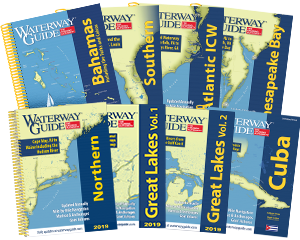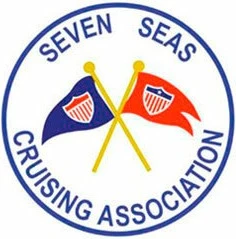
When it's time to anchor, it's "The Big Five"- size, shape, strength, scope, and anti-chafe techniques that count. Get all of them right and dragging, tripping or breaking loose will be a thing of the past.
Each of "The Big Five" performs a specific function, a function that cannot be performed by one of the others. Substituting one of "The Big Five" to perform the function of one of the others only increases the odds for dragging, tripping or breaking loose. For example, your anchor may be big enough to handle an approaching gale (28-47 knot winds), but what about the other components in the ground tackle system? Are your shackles and all of the other components strong enough to handle the loads?
Size Classification societies recommend that anchors have twice the holding power of that of the load on the ground tackle. In order to determine what the load on the ground tackle will be, you will need the information found in some of the books on anchoring; our book, Anchoring- A Ground Tackler's Apprentice, provides this information.
While this may appear straightforward, it is somewhat misleading, as the anchor must have this amount of holding for the softest bottom in which it will be used. For example, since mud has 1/3 to 1/6 the resistance, as compared to firm sand, even though the load on the anchor has not increased, due to the seabed's lower resistance, the anchor must be 1 to 3 sizes larger for use in mud, if it is to have the same holding power as it would in firm sand.
Shape The anchor must have a design that allows it to set, and then hold, in the specific type of bottom in which it will be used. These two functions, setting and holding, depend on the anchor having a fluke angle that is specific to the type of bottom in which it will be used. If the anchor has any other fluke angle, the anchor has to be bigger, 1 to 2 sizes bigger; this increase in size must be over and above any additional size increase made, when sizing for soft bottoms.
Strength Each piece of gear in the ground tackle, from the anchor up to and including the belaying point, must not only have enough strength, it must also have some strength kept in reserve, a Safety Factor, in case the load on the ground tackle exceeds that which was calculated.
In order to have this reserve strength, only an item's Work Load Limit (WLL) is to be used to size the item, with the WLL equaling or exceeding the load that was calculated for the ground tackle.
For rope, since it does not come with a WLL, only its tensile strength is provided, the ABYC standards specify that, for ground tackle, a rope's tensile strength should be at least eight times the maximum load on the ground tackle.
Scope The smaller the angle formed by the rode relative to the bottom, the rode-to-bottom angle, the better that the anchor will hold. Scopes of 10:1 for all rope rodes, 7:1 for rodes that are 1/2 rope-1/2 chain, and 5:1 for all chain rodes, work, but only in mild conditions because the catenary, that sag in the rode due to the rode's weight, allows the rode to form a zero rode-to-bottom angle.
As the wind rises, the rode lifts off the bottom and the catenary starts to decrease, increasing the rode-to-bottom angle. To emphasize the risk that is associated with a decreasing catenary:
- Fortress Anchors points out that anchors with a 5:1 scope have only half the holding power as they would with a 10:1 scope. Other entities have data that mirrors this finding.
- British Royal Navy points out that when the rode-to-bottom angle has an angle of 10 degrees (6:1 scope), the anchor loses 40 percent of its holding power, and at 15 degrees (4:1 scope), the loss is 60 percent.
Therefore, as the wind speed rises, these old, long used rules-of-thumb for scope should be dispensed with, and focus should instead be directed to achieving and maintaining no more than a six-degree rode-to-bottom angle. In a rode with no contributing catenary, a six- degree rode-to-bottom angle is obtained when the scope is no less than 10:1
Anti-Chafe Techniques No rode will remain intact for long if it's subjected to chafe or if it develops enough heat to cause the fibers to melt. There are numerous techniques that can, and should be used to minimize, or better yet, eliminate the problems of chafing and melting. All of these techniques fall into one of four categories- reduce, replace, cover or transfer. Fortunately, any of the techniques, regardless of its category, can be mixed or matched with one another as is needed.
But There Is More Get all of "The Big Five" right, or at least do not get them wrong, and anchoring will generally be without problems… maybe! Actually, there is a sixth member of "The Big Five"- multiple anchors.
Whereas each of "The Big Five" is involved every time an anchor will be deployed, the use of more than one anchor is employed only when the circumstances dictate the need, most often:
- To avoid tripping the anchor;
- To avoid fouling the rode;
- To limit the boat's swing radius;
- To keep the boat away from dangers.
This need often appears where currents reverse, winds shift, or in tight anchorages. The deployment of more than one anchor, when necessary, should always be willingly employed.
Finally Not only are "The Big Five" instrumental in sizing the gear for use in ground tackle, they can also be used to identify the culprit(s) should your anchor drag, trip or your boat break loose. In addition, "The Big Five" can also be used to determine at what point your existing gear may no longer be reliable and should be switched out for heftier gear.
Find out more about veteran cruisers Rudy and Jill Sechez, Trawler Training and Anchoring Consultants, at their website: www.trawlertrainingabc.com.
You can find additional information in ANCHORING-A Ground Tackler's Apprentice by Rudy and Jill Sechez, available at Waterway Guide Ship Store- and now in the Waterway Guide Mobile App!












